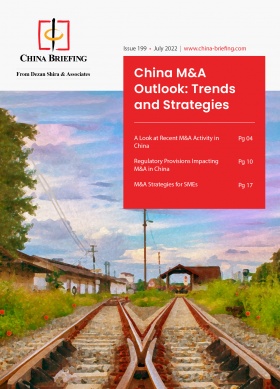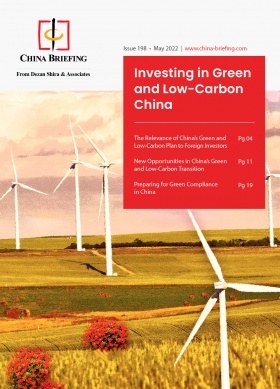China’s Provincial GDP in H1 2022: Who Were the Top Performers?
Over 80% of China’s 31 provinces registered growth in GDP in Q2 and H1 2022, despite domestic and international headwinds dampening the overall economic outlook. In H1 2022, Guangdong continued to lead the country in GDP growth while Ningxia Province recorded the fastest GDP growth and Beijing overtook Shanghai to become city with the largest GDP in China. However, Shanghai retains the economic advantages to quickly retain its title – likely within 2022 itself. China’s eastern regions account for bigger GDP, but the middle and western provinces are growing at a faster rate. China’s economy will grow at around 4% in 2022 as the government does not intend to overheat the economy with flood-irrigation stimulus.
On July 15, 2022, the National Bureau of Statistics (NBS) announced that China’s GDP grew 2.5 percent in the first half (H1) of 2022, compared to the same period in the previous year, to reach RMB 56,264.2 billion (US$8327.1 billion).
Authorities also unveiled data tracking the economic performance of 31 provinces, autonomous regions, and municipalities directly under the Chinese Central Government for Q2 and H1 of 2022. Strong stimulus policies appear to have cushioned China’s economy from the worst of the COVID-19 outbreaks in the second quarter of the year.
In this article, we dive into the GDP and growth rate of prominent provinces in China to help investors get a better gauge of major growth trends in the country.
According to the NBS, China’s GDP in H1 2022 was RMB 56,264.2 billion (US$8327.1 billion), up 2.5 percent year-on-year (YOY) at constant prices.
Most regions maintain growth momentum
In Q2 2022, most regions in China had stable economies. In fact, 26 provinces of the total 31 regions registered growth in GDP in Q2 2022.
Except for Shanghai (-13.7%), Beijing (-2.9%), Jilin (-4.5%), Jiangsu (-1.1%), and Hainan (-2.5%), all other provinces registered positive economic growth amid downward pressure in Q2.
In H1 2022, the GDP growth of 23 provinces was equal to or outpaced the national growth rate. Only Shanghai (-5.7%) and Jilin (-6.0%) had negative GDP growth.
Top three provinces by GDP: Guangdong, Jiangsu, and Shandong
In H1 2022, Guangdong’s GDP reached RMB 5,951.8 billion (US$882.7 billion), accounting for 10.57 percent of the national total and continuing to lead the country. Another province with a GDP of over RMB 5 trillion (US$0.74 trillion) in the first half of the year was Jiangsu Province, which ranked second with RMB 5,690.9 billion (US$844.0 billion). Shandong’s GDP of RMB 4,171.7 billion (US$618.7 billion) ranked third in China.
Guangdong Province has a very convenient geographical position, complete industrial base, and relatively open market so the provincial GDP has always shown high growth. In H1 2022, despite pandemic outbreaks in Dongguan, Shenzhen, and other cities in the province, the regional government did not implement large-scale and long-term lockdowns. It is no surprise then that Guangdong Province retained its leading position in H1 2022.
Jiangsu and Shandong’s rankings are the same as last year.
Province demonstrating the fastest GDP growth: Ningxia
Nationally speaking, the top five provinces registering GDP growth in the first half of the year were Ningxia (5.3%), Shanxi (5.2%), Xinjiang (4.9%), Jiangxi (4.9%), and Tibet (4.8%), according to official data. Ningxia is the province with the fastest GDP growth in H1 2022.
Among China’s top 10 provinces by GDP output, Fujian Province recorded the fastest growth of 4.6 percent, while its GDP in H1 2022 reached RMB 2,460.5 billion (US$364.9 billion), ranking seventh in the country.
While Ningxia’s total economic output does not feature prominently in the national GDP rankings, it has emerged as a black horse among China’s central and western regions. Between 2010 to 2020, Ningxia’s GDP grew by 139 percent.
In the past five years, Ningxia’s total investment in fixed assets has exceeded RMB 1 trillion (US$148.2 billion), contributing more than 50 percent to its economic growth. Ningxia is home to several major projects, such as the world’s largest coal-to-liquid project (in terms of single/initial investment), Central Photovoltaics’ 50GW monocrystalline silicon project, and Runergy’s photovoltaic materials project, among others.
Moreover, Ningxia’s foreign trade has accelerated in the past two years. According to Yinchuan Customs, in 2021, Ningxia’s total import and export volume of goods trade reached RMB 21.4 billion (US$3.2 billion), up 73.4 percent YOY, and the growth rate ranked second in the country.
In the first half of 2022, Ningxia’s foreign trade continued growing. With the Regional Comprehensive Economic Partnership (RCEP) coming into force, Ningxia’s import and export value reached RMB 12.25 billion (US$1.8 billion) in H1 2022, up 70.1 percent YOY, and the growth rate ranked first in China.
Beijing surpasses Shanghai for the first time
In the first half of 2022, Beijing ranked 12th in China with a GDP of RMB 1,935.2 billion (US$286.9 billion), followed by Shanghai in 13th place with a narrow gap of RMB 300 million (US$44.5 million). This marks the first time that Beijing’s GDP has surpassed that of Shanghai and become the city with the largest GDP in China.
To contain COVID-19 flare-ups, Shanghai implemented a city-wide lockdown that lasted over two months in the second quarter of the year. The stringent lockdown measures seriously disrupted supply chains and production plans of enterprises operating in Shanghai. As a result, Shanghai’s economy registered a 13.7 percent decline in Q2 2022. The overall growth rate of Shanghai’s GDP in H1 2022 fell by 5.7 percent YOY.
Nevertheless, Beijing’s GDP growth was also minimal due to the disruption caused by the pandemic – its economy only grew 0.7 percent YOY.
In the long term, Shanghai still enjoys economic advantages over Beijing. While Beijing is dominated by the tertiary industry, Shanghai is strong in both secondary and tertiary industries. Shanghai’s industries are more diversified—it is not only China’s largest industrial city but also the largest financial and trade center.
As its industry, investment, and foreign trade rebounded quickly after the lockdown, it is expected that Shanghai will be able to make up the gap with Beijing—within the year itself.
Eastern regions have bigger GDP but middle and western provinces grew faster
According to the data, the top 10 provinces in terms of GDP are mainly distributed in the east, especially the coastal areas. The combined GDP of the top five eastern coastal provinces—Guangdong, Jiangsu, Shandong, Zhejiang, and Fujian—was RMB 21.89 trillion (US$3.25 trillion), accounting for more than one third of the national total. That is to say, China’s economic center is still concentrated in the coastal provinces and impacts the overall economic stability of the country.
On the other hand, the central and western regions performed better in terms of rate of growth. In Q2 2022, the GDP of the central and western regions grew by 2.3 percent and two percent YOY, respectively. Both regions grew faster than the national growth rate, which was 0.4 percent in Q2 2022. Further, in H1 2022, the added value of industrial enterprises above the designated size in the central and western regions both grew 7.3 percent YOY—5.1 percentage points faster than that in the eastern regions.
Compared with the eastern regions, the impact of the COVID-19 pandemic was relatively weak in the central and western regions. Moreover, a series of national plans for the development of the western region, the rise of the central region, and the construction of the Chengdu-Chongqing twin city economic circle are starting to show their effect.
Shanghai and Jilin are catching up
Shanghai and Jilin provinces were hit the hardest by COVID, and their GDP declined 13.7 percent and 4.5 percent in Q2 2022, respectively. However, with the COVID-19 outbreaks back under control, enterprises resumed work and production at a faster pace and major economic indicators improved significantly in June.
In June, the added value of industrial production above the designated size in Shanghai and Jilin grew 13.9 percent and 6.3 percent YOY, respectively, after falling 30.9 percent and 4.9 percent, respectively, in the previous month.
In terms of consumption, Jilin’s retail sales of consumer goods above the designated size rose 5.5 percent in June, after falling 1.5 percent in May.
In terms of employment, the surveyed urban unemployment rates in Shanghai and Jilin dropped 9.7 and 0.8 percentage points, respectively, from the previous month.
All these data points show that Shanghai and Jilin are quickly catching up to other high performing provinces.
| GDP Ranking of 31 Provinces in 2022 H1 | |||
| Ranking | Provinces | GDP (billion RMB) | Growth rate (%) |
| 1 | Guangdong | 5,951.80 | 2 |
| 2 | Jiangsu | 5,690.90 | 1.6 |
| 3 | Shandong | 4,171.70 | 3.6 |
| 4 | Zhejiang | 3,622.20 | 2.5 |
| 5 | Henan | 3,075.70 | 3.1 |
| 6 | Sichuan | 2,617.60 | 2.8 |
| 7 | Fujian | 2,460.50 | 4.6 |
| 8 | Hubei | 2,450.30 | 4.5 |
| 9 | Hunan | 2,293.30 | 4.3 |
| 10 | Anhui | 2,176.40 | 3 |
| 11 | Hebei | 1,982.40 | 3.4 |
| 12 | Shanghai | 1,934.90 | -5.7 |
| 13 | Beijing | 1,932.50 | 0.7 |
| 14 | Shaanxi | 1,525.20 | 4.2 |
| 15 | Jiangxi | 1,513.30 | 4.9 |
| 16 | Chongqing | 1,351.20 | 4 |
| 17 | Yunnan | 1,346.40 | 3.5 |
| 18 | Liaoning | 1,317.30 | 1.5 |
| 19 | Guangxi | 1,229.40 | 2.7 |
| 20 | Shanxi | 1,156.90 | 5.2 |
| 21 | Inner Mongolia | 1,046.50 | 4.3 |
| 22 | Guizhou | 983.00 | 4.5 |
| 23 | Xinjiang | 827.90 | 4.9 |
| 24 | Tianjin | 762.10 | 0.4 |
| 25 | Heilongjiang | 639.50 | 2.8 |
| 26 | Jilin | 569.70 | -6 |
| 27 | Gansu | 523.50 | 4.2 |
| 28 | Hainan | 314.50 | 1.6 |
| 29 | Ningxia | 235.20 | 5.3 |
| 30 | Qinghai | 168.90 | 2.5 |
| 31 | Tibet | 97.30 | 4.8 |
| Source: National Bureau of Statistics | |||
| GDP Ranking of 31 Provinces in 2022 Q2 | |||
| Ranking | Provinces | GDP (billion RMB) | Growth rate (%) |
| 1 | Guangdong | 3,102.00 | 0.7 |
| 2 | Jiangsu | 2,905.00 | -1.1 |
| 3 | Shandong | 2,179.10 | 2.1 |
| 4 | Zhejiang | 1,833.60 | 0.1 |
| 5 | Henan | 1,652.80 | 1.7 |
| 6 | Hubei | 1,369.80 | 2.7 |
| 7 | Sichuan | 1,343.70 | 0.5 |
| 8 | Fujian | 1,274.60 | 2.6 |
| 9 | Hunan | 1,187.50 | 2.7 |
| 10 | Anhui | 1,141.60 | 1 |
| 11 | Hebei | 1,026.40 | 1.7 |
| 12 | Beijing | 993.90 | -2.90 |
| 13 | Shanghai | 933.90 | -13.7 |
| 14 | Shaanxi | 798.70 | 3.3 |
| 15 | Jiangxi | 781.30 | 3 |
| 16 | Chongqing | 711.40 | 2.9 |
| 17 | Yunnan | 699.80 | 1.9 |
| 18 | Liaoning | 695.80 | 0.4 |
| 19 | Guangxi | 637.90 | 0.7 |
| 20 | Shanxi | 605.60 | 3.9 |
| 21 | Inner Mongolia | 538.70 | 3 |
| 22 | Guizhou | 501.50 | 2.5 |
| 23 | Xinjiang | 430.40 | 2.9 |
| 24 | Tianjin | 408.20 | 0.7 |
| 25 | Heilongjiang | 341.90 | 0.5 |
| 26 | Jilin | 312.10 | -4.5 |
| 27 | Gansu | 275.60 | 3.2 |
| 28 | Hainan | 155.10 | -2.5 |
| 29 | Ningxia | 123.80 | 5.3 |
| 30 | Qinghai | 85.50 | 0.1 |
| 31 | Tibet | 45.60 | 3.2 |
| Source: National Bureau of Statistics | |||
What to expect in the second half of 2022?
Given current domestic and international headwinds, hitting the 5.5 percent annual growth target is almost a mission impossible for China, if it doesn’t want to overheat the economy with flood-irrigation style stimulus.
Based on a speech delivered by Premier Li Keqiang at a World Economic Forum video session, it is understood that China will not introduce large-scale stimulus measures, over issue the Renminbi currency, and overdraft the future to achieve the high growth target. Rather, China’s economic policies would be “targeted, forceful, and reasonable”.
Also, in the Politburo‘s quarterly meeting on the economy held on July 28, 2022, a gathering of the Chinese Communist Party’s most powerful members, it was announced that China will target to “maintain economic operations in a reasonable range and strive to achieve the best results“ in H2 2022 (rather than achieve “expected results”). This was regarded as an official indication that the 5.5 percent annual GDP growth target is no longer feasible.
Under this condition, most analysts predict that China’s economy will grow at around four percent in 2022.
Zhu Baoliang, chief economist of the State Information Center under the National Development and Reform Commission (NDRC) said at the 2022 Mid-Term Macroeconomic Summit that it would be good if the economy can grow 5.5 percent in the second half of the year and the whole year growth rate for 2022 be around four percent.
Liu Yuanchun, president of Shanghai University of Finance and Economics, and a trusted economic advisor to President Xi Jinping and Premier Li Keqiang, also estimated in a recent interview that the Q4 economic growth rate will be 6.3 to 6.4 percent and the 2022 annual economic growth rate will be around 4.8 percent.
On the other hand, the International Monetary Fund (IMF) projection released on July 26 downgraded China’s growth by 1.1 percentage points to 3.3 percent in 2022. This would be the lowest level recorded by China in more than 40 years. This prediction was made by factoring in China’s ongoing COVID-19 outbreaks and lockdowns, the real estate crisis, and further negative global spillovers (Russian-Ukraine Conflict, high inflation in US and other major countries, and the potential European debt crisis).
Despite the fact that China is walking away from its 5.5 percent annual growth rate target, it still needs to tackle the unemployment issue and boost business confidence, which are important to the overall stability of the country.
Thus, moderate stimulus and more pro-business measures can be expected to be released in the second half of the year. We will keep monitoring China’s macro and micro economic policies for businesses operating in China.
About Us
China Briefing is written and produced by Dezan Shira & Associates. The practice assists foreign investors into China and has done so since 1992 through offices in Beijing, Tianjin, Dalian, Qingdao, Shanghai, Hangzhou, Ningbo, Suzhou, Guangzhou, Dongguan, Zhongshan, Shenzhen, and Hong Kong. Please contact the firm for assistance in China at china@dezshira.com.
Dezan Shira & Associates has offices in Vietnam, Indonesia, Singapore, United States, Germany, Italy, India, and Russia, in addition to our trade research facilities along the Belt & Road Initiative. We also have partner firms assisting foreign investors in The Philippines, Malaysia, Thailand, Bangladesh.
- Previous Article Ein Blick auf die jüngsten M&A-Aktivitäten in China
- Next Article China Export Tax Refund Policy: Recent Changes, Documentation Process, Foreign Exchange Management









